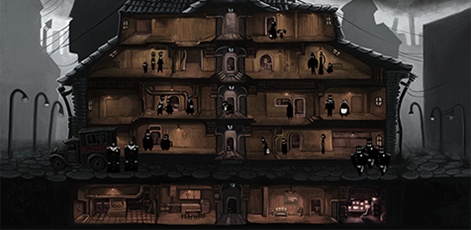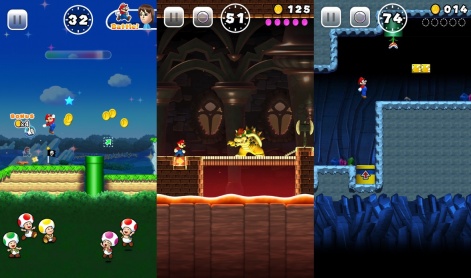Vladimir Funtikov is CEO of Creative Mobile.
Beholder is a very special project for us, not only because it's a very special game - gritty, dark and satirical - but also because it presented a unique challenge for Creative Mobile as a publisher.
Originally a Steam title developed and published by Alawar, Beholder is a paid game, and one that can’t be easily translated into a great free-to-play experience. The fundamental principle of freemium - instant and repeatable pleasure from purchase - wouldn’t work in a game about hard decisions.
Watching a Gardenscapes ad to save your daughter from dying today didn’t quite fit. So rather than risk destroying the fragile emotional balance, we agreed to publish the mobile adaptation of Beholder as a paid title - something we hadn’t done in six years.
Going with this model meant that the most reliable and scalable user acquisition tactics wouldn’t pay off. With original IP, it’s very hard to sell a game at price points above $5 because of the existing perception of the market, regardless of its true value.
Without IAPs or ads, the sale price becomes your ARPPU (average revenue per paying user). Additional paid content can improve it, but only in small steps, as it is expected to cost even less than the base game.

ARPPU and conversion rate ultimately command the maximum UA cost a game can turn a profit on. Single-digit ARPPU is so far below the standard set by top freemium games, even great conversion wouldn’t save the day.
As a result, paid games just can’t compete in any bidding contest. So instead of trying to make performance marketing work, we focused on the other available tools, including playing to the strengths of each distribution platform.
App Store versus Google Play
In line with the fundamental philosophies of Apple and Google, the App Store is the more curated platform, while Google Play is more reliant on AI-driven recommendations.
After observing sales for about a month, we agreed to deploy a free try-and-buy version to co-exist with the paid game.
Clever algorithms are fantastic for driving organic discovery of free games, but because they feed on data, they need significant download volumes to fully kick in, putting paid games at a disadvantage.
With this in mind, our expectations from publishing a paid title on Google Play were initially lowered. The game launched in May priced at $4.99 and was well received, settling at a 4.7-star review rating and ranking top three in its category in all markets, which seemed appropriate for a relatively niche, serious title.
Revenue was in line with what we reasonably expected, but well behind App Store sales, and any hopes of a miracle were crushed.
Underwhelming results had an obvious positive element: they opened the door for “plan B”.
After observing sales for about a month, we agreed to deploy a free try-and-buy version to co-exist with the paid game. The option was always on the table and supported by Alawar, who relied on it successfully in the past.
On the other hand, there was Super Mario Run, which was notoriously bashed for its $10 unlock IAP just recently, and we decided to play it safe.

Even after the initial launch, opinions were split. In addition to possible backlash from the players, there was the risk of cannibalising the paid game sales. But true to our spirit, we decided that failure was better than uncertainty, and went ahead.
Try-and-buy
The initial results were hardly impressive - after two weeks on the market the free version was seeing 500 to 1,000 daily downloads. I don’t think anyone should complain about one thousand customers walking into their store every day, but it wasn’t enough to move the needle for us.
Eventually, growth continued, and in just over a month the try-and-buy version seemed to level off at healthy 7,000+ organic downloads per day. With conversion to payers in line with typical F2P game figures, the impact was now noticeable.
We didn’t see any cannibalisation of the sales of the paid version - instead, it seemed to improve.
Although the description of the game made it clear it was a try-and-buy demo, we didn’t expect too many people to read it and prepared to deal with hundreds of players frustrated by the paywall.
In practice, there were some negative comments, but average score settled at the same 4.7-star rating as the paid game.
Moreover, we didn’t see any cannibalisation of the sales of the paid version - instead, it seemed to improve. Conversely, running a “back to school” discount event on the original game boosted its sales 10x, but had no negative impact on the free game organics.
Surprised, we sent our findings to the Google Play team as part of our feedback routine, who in turn deemed the game worthy of a spot in the weekly promotion reel. We were excited, but didn’t expect the numbers to scale well.
However, during the promotion, conversion to payers didn’t dip and even grew slightly. The review score took a small hit, but still rounded up to 4.7. Most surprisingly, as free game downloads and IAPs spiked, so did the paid game sales.
At the peak of the promo, paid version was +700% up compared to the previous period, narrowly beating its own launch week results. In some markets, Beholder was simultaneously top five in both Free and Paid, and top 20 grossing with both versions.
Understanding the platforms
After the promotion ended, the try-and-buy version reverted to the same organic downloads as before and is now closing in on the one million mark, while the pay-once game stabilised at a multiple of its previous level.
Combined, the try-and-buy and full versions are grossing over five times of what the paid game managed on its own - now a very sizeable contribution on the project scale.
Additionally, the increased organic download volume allowed us to use the Google Play A/B testing feature and iterate on our store page assets for better conversion.
It’s worth noting once again that Beholder is a special game. It explores a theme that doesn’t appeal to everyone, but those who appreciate it become super-fans. It is very well-received by the press, earning numerous awards and making “game of the year” lists.
Originally a Steam title, it came with an established player base, and the development team have been doing a fantastic job of talking to their audience passionately and authentically.
Finally, we wouldn’t be able to get the necessary exposure without support from the App Store and Google Play developer relations teams.
That said, we believe that understanding the mechanics of each platform is a very important component of mobile marketing and playing to the strengths of each major channel can make a big difference for any game or app.





















